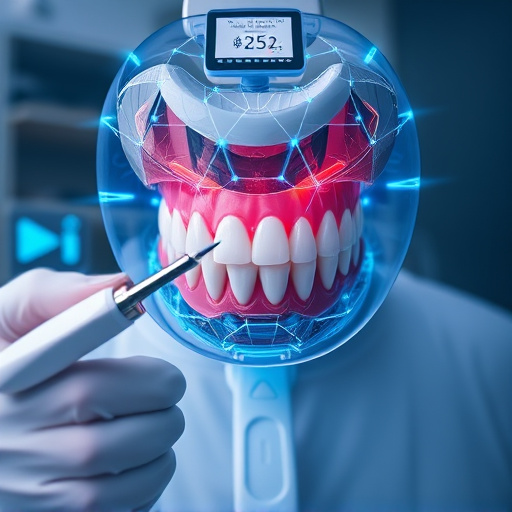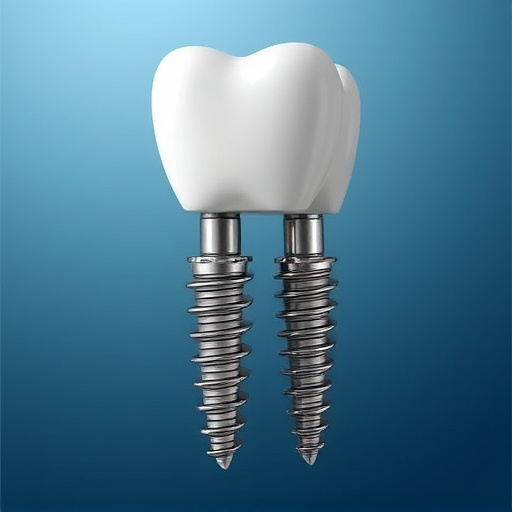Crown lengthening procedure enhances tooth visibility by reducing gum tissue covering teeth, ideal for preparing teeth for crowns, clear aligners or other restorative dentistry. It modifies gum lines and bone structures to expose more natural teeth, aiding precise dental impressions crucial for accurate and long-lasting restorations. This process improves chewing function, oral health, and simplifies future procedures like extractions and bonding, ultimately promoting long-term oral health benefits.
Crown lengthening, a specialized dental procedure, plays a pivotal role in enhancing precision during treatment. This technique involves carefully modifying gum tissue and bone to expose more of a tooth’s structure. By achieving accurate impressions, dentists can create custom-fitted crowns, bridges, or veneers that seamlessly blend with the natural teeth. Understanding crown lengthening demystifies its importance in modern dentistry, ensuring optimal results for patient care.
- Understanding Crown Lengthening: A Basic Guide
- The Role of Accurate Impressions in Dentistry
- How Crown Lengthening Facilitates Better Dental Work
Understanding Crown Lengthening: A Basic Guide

Crown lengthening, also known as gingival or soft tissue crown lengthening, is a surgical procedure that aims to increase the amount of visible tooth by reducing the gum tissue that covers it. This process is often considered when there isn’t enough tooth structure exposed for ideal restoration, especially in cases where teeth appear short or misaligned despite healthy gums and roots. It’s particularly useful when preparing a tooth for a dental crown, clear aligners, or other restorative dentistry procedures.
The procedure typically involves making incisions in the gum tissue to expose more of the natural tooth. The surgeon carefully removes some gum tissue while preserving the bone that surrounds the teeth. This allows for a longer tooth exposure, providing a more stable and esthetically pleasing foundation for future dental work. After crown lengthening, patients may experience some swelling and discomfort, but this is usually manageable with prescribed medications.
The Role of Accurate Impressions in Dentistry

In dentistry, accurate impressions are paramount to successful treatment outcomes. They serve as precise blueprints for crafting custom dental restorations, ensuring that every detail of a patient’s oral geometry is captured and replicated perfectly. Whether it’s fitting a crown, bridge, or implant, an impression that accurately reflects the length and contour of the tooth (or teeth) is crucial. This is where the crown lengthening procedure comes into play. By gently modifying the gum line and bone structure to expose more of the natural tooth, this procedure creates the necessary space for taking impressions that are both detailed and accurate.
This meticulous process is not only about aesthetics; it’s equally vital for functional restoration. An impression that accurately depicts the length of a tooth allows dental professionals to create restorations that fit seamlessly, promoting proper chewing function and overall oral health. Moreover, considering the role of dental bonding or fillings in the treatment plan, precise impressions are essential to ensure these materials adhere correctly and blend seamlessly with surrounding teeth. In essence, accurate impressions facilitated by crown lengthening procedures form the bedrock upon which reliable and long-lasting dental work is built.
How Crown Lengthening Facilitates Better Dental Work

Crown lengthening procedure plays a pivotal role in enhancing the precision of dental work. By gently reshaping the gums and exposing more tooth enamel, this procedure provides dentists with a broader area to work on. This is particularly beneficial for restorative dentistry techniques like dental bonding, where a strong bond between the restoration and natural tooth is crucial. It also ensures that any subsequent tooth extractions can be performed with greater ease, allowing for better access during surgical procedures.
Moreover, crown lengthening facilitates more accurate impressions of the teeth. Detailed and precise dental impressions are essential for crafting customized crowns, bridges, or other dental devices. The exposed enamel provides a clearer picture of the tooth’s anatomy, enabling dentists to create restorations that fit seamlessly and offer optimal functionality and aesthetics. This, in turn, leads to higher patient satisfaction and long-term health benefits for the oral cavity.
Crown lengthening procedure plays a pivotal role in enhancing dental precision. By accurately increasing the visible portion of teeth, this technique enables dentists to create better impressions and perform more effective treatments. The benefits are clear: improved aesthetics, enhanced functionality, and longer-lasting results. Understanding crown lengthening and its advantages is essential for anyone seeking optimal oral health and confident smiles.














